I’m ever so happy to see you today. Grab a cup of coffee and join me in the kitchen for our beginner canning tutorial.
Okay, so you’ve tried your little test batch, adjusted the sugar and are ready to can like crazy. Just wait ’til you open one of your long term storage jars on some blustrous winter morning. All the tastes of Summer. Yum!
Here were the first steps, in case you missed them:
How To Make Jam — A Beginner Tutorial
How To Make Jam — The Canning Supplies
Here we go:
1. Wash everything.
Every pot, spoon, tong, tool, jar, dome lid and band. Plus, every surface you might possibly use.
2. Place mostly dried jars, on their sides, in a slow oven ( 200 degrees Fahrenheit ) for one hour to sterilize a load of jar at once.
3. Meanwhile place all the tools, dome lids and bands in a pot of water no cooler than 180 degrees Farenheit for no less than 15 minutes.
3a. Set stock pot of water for water bath on high so it comes to a boil just before, your jars go into it. Yeah, this can take a while.
4. Make the jam of your choice.
5. After you skim any foam from the surface, pour the wicked hot jam into jars, using a canning funnel to keep things clean. This is called hot packing.
6. Using the magnetic lid lifter, place a dome lid on each hot jar.
7. Using the magnetic lid lifter to remove the bands from the scalding water, place them over each band.
8. Dip your hands in a giant bowl of ice water for a moment and screw on each band. Use a jar wrench to tighten, if you have one.
Note: If you have delicate hands, you may need to thrust your hands back into the icewater between each jar you tighten.
9. Place the jars into the boiling water bath.
Note: there should either be a canning rack or a bunch of band lids on the bottom of the water bath to prevent the jars from directly touching the bottom of the pot. Also, there should be at least 1 inch of water above the tops of the jars.
10. Process for 15 minutes.
Yup, that just means leave the jars in the boiling water bath for 15 minutes.
Altitude adjustment: For every 1000 ft. you are above sea level, add 1 minute.
So for example: I live at 1050 ft. so I process my jam for 16 minutes. High Mountain Muse probably processes hers for a year and a half way up there on her mountain top.
11. Using the jar lifters, take the jars out of the water and set them to cool on whatever clean flat surface is left.
12. As the jars cool listen for that delightful popping sound of each jar sealing. You can tell it is sealed when you run your finger over the dome lid and it has sucked down. Man, that is a satisfying sound!
There is nothing more satisfying than seeing a rainbow of sparkly jams all set to nourish your family until next canning season.
Now, who’s baking the biscuits?


